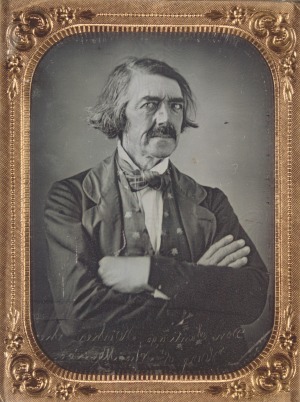James Kirker facts for kids
James Kirker (1793–1852) was an Irish-born American who had many jobs. He was a privateer (a legal pirate), a soldier, a merchant, and a Mountain man. He is mostly known for working with the Mexican government. His job was to fight against some Apache groups.
Early Life and Adventures
Kirker was born in Killead, County Antrim, in Northern Ireland. When he was 16, he moved to New York City, United States. He wanted to avoid joining the British Navy.
During the War of 1812, Kirker became an American privateer. This meant he had permission to raid British ships. After a year, he returned to New York in 1813. He married Catherine Donigan and had a son named James B. Kirker.
In 1817, Kirker left his family and moved to St. Louis, Missouri. There, he worked as a merchant. In 1822, he joined a fur trapping trip up the Missouri River. Two years later, in 1824, he traveled the Santa Fe Trail to New Mexico. For the next ten years, he trapped and traded beaver furs in the southern Rocky Mountains.
He also worked at the Santa Rita mine near Silver City, New Mexico starting in 1826. He helped transport copper by wagon to Chihuahua, Mexico. In 1833, he married Rita Garcia in Mexico. He became a Mexican citizen in 1835. They had three sons and a daughter. In Mexico, people knew him as Santiago Querque or Quirque.
People described Kirker as a "large, agile man." He was brave and very skilled with a gun and on horseback. Many thought he had "great enterprise and vision" during his lifetime.
Working for the Mexican Government
Over the years, Kirker became familiar with the Apache people. He even sold them weapons and supplies. Some people said he joined Apache groups on raids to steal livestock in Mexico.
Starting in 1831, raids by Apache groups became a big problem. This was especially true in the Mexican states of Chihuahua and Sonora. In December 1839, the government of Chihuahua hired Kirker. His job was to fight against Apache groups. He was allowed to gather 200 men for his team. He would be paid for capturing Apache people.
His main group had about 25 men. They were called "Sahuanos." This group included Americans, Mexicans, and even escaped Black slaves. It also had Shawnee, Delaware, and Creek Native Americans. His second-in-command was a Shawnee named Spybuck.
In 1840, Kirker's team killed 10 Apache men. They also captured 20 women and children. These Apache had been trying to make peace with Mexican officials. Kirker continued to have some success in fighting and capturing Apache. However, Apache raids actually increased in 1841.
Kirker was hired again in 1846. He and local Mexicans were involved in a sad event. About 130 peaceful Apache were killed at Galeana, Chihuahua. Kirker said he had followed a trail of stolen livestock to their camp.
The Chihuahua government was running out of money. They could not keep paying Kirker. They offered him a high rank as a Colonel in the Mexican Army instead. Kirker did not accept this offer. Public opinion turned against Americans because of the Mexican–American War. Kirker left Mexico. He was declared an enemy of the state, and a large reward was offered for his capture.
Life After Mexico
After leaving Mexico, Kirker worked as a scout for the American army. He helped Col. Alexander William Doniphan during the American invasion of northern Mexico. This was part of the Mexican–American War.
In 1848, he was a scout for another American trip. This trip was against the Apache and Ute groups. In 1849, he guided a group of "Forty-Niners" to California. These were people looking for gold.
Kirker settled with his family in Contra Costa county in California. Places like Kirker Creek and Kirker Pass are named after him. However, by 2022, some people began to question these names. This was because of the violent events he was involved in. James Kirker died in 1852.
It can be hard to know what is completely true about Kirker's life. Many stories about him mix facts with old tales.


